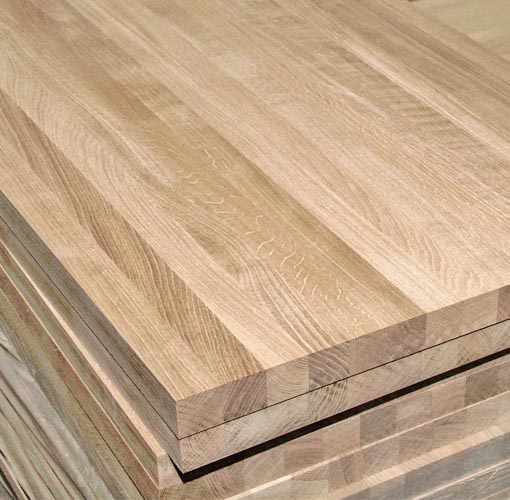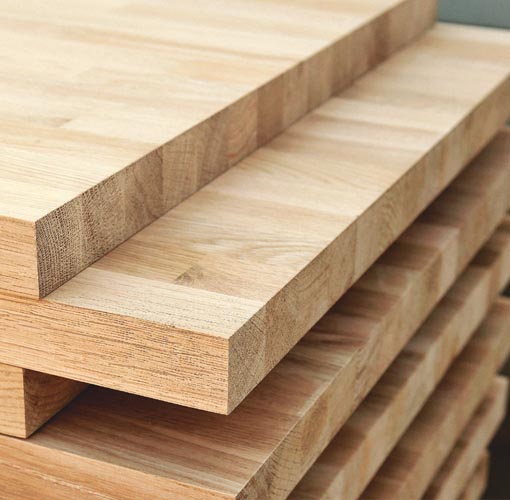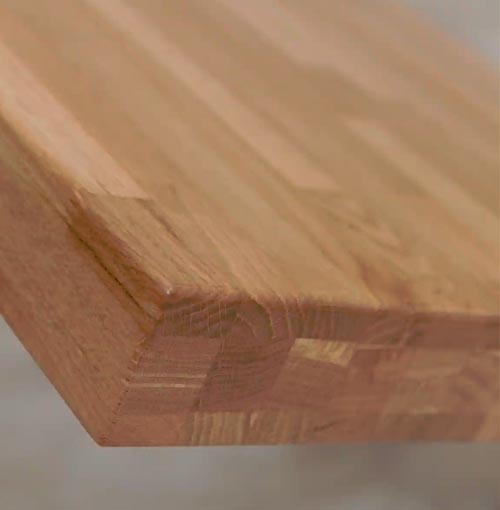
Edge-glued solid wood panels are made by gluing together individual pieces or strips of hardwood along their edges. We use full-length lamellae planed on 4 sides. We glue the lamellae to each other side by side width-wise, creating a large surface area. The lamellae are as long as the panels and their length depends on the raw materials. If the lamella is wide, the panel will have a more natural appearance.
Edge-glued solid wood panels maintain the natural appearance of the wood, such as grain patterns, knots, and colour variations. Later on, it will be possible to finish the panels with varnishes, stains, and various coatings to protect and improve their appearance.
Apart from their appearance, edge-glued solid wood panels are valued for their versatility. They can be used for making furniture, cabinetry, shelving, countertops, tabletops, wall panelling, and more. Our customers will be able to cut, shape, and finish the panels according to their applications.
Thanks to our high-precision machinery, our edge-glued solid wood panels are strong and stable. The edge-gluing process will distribute the weight and tension evenly across the panels. We glue the lamellae in a perpendicular orientation, to improve stability to temperature and humidity changes.
Thanks to the edge-gluing process, the continuous lamellae will not warp, twist, or split. They can be used for structural and load-bearing applications.
Edge-glued panels are excellent for wide dining room tables, shelving, wooden doors, flooring, and much more. They can create dimensionally stable hardwood panels for a solid and uniform look.

Finger-joint solid wood panels are made by joining short lengths of solid wood with the specialized woodworking technique, which is finger jointing. We interlock the profiles (fingers) at the ends of the wood pieces to generate longer lengths of material. The short lamellas will be glued to each other on 4 sides.
We run precision-driven processes so that our finger-joint panels present excellent structural integrity. The risk of warping, twisting, or splitting is low for these solid hardwood panels. The process also gives the panels uniformity in dimensions and appearance. There is a seamless transition between wood pieces. The surface is continuous and smooth, with no obvious joints or irregularities.
We use short lengths of wood and also wood that would otherwise be discarded as waste. Finger-joint solid wood panels are more affordable to produce than single-strip, full-length panels. The material costs are more affordable as we use short wood pieces.
Finger-joint panels are environmentally friendly. We use sustainably harvested oak or beech wood.
Even if finger-joint solid wood panels don’t have the same beauty as natural wood, they still offer a pleasant appearance for many applications. They have consistent colour and grain patterns that generate an appealing finish.
The structural integrity of finger-joint solid wood panels is excellent. Their strength and stability recommend finger joint panels for load-bearing applications and environments where dimensional stability is crucial.
Finger-joint solid wood panels are versatile and can be used for making furniture, shelving, cabinetry, steps and countertops, decorative wood slats, flooring, wall paneling, and more. They can be cut, shaped and finished according to the application.

Multilayer solid wood panels are a type of engineered wood panel made by bonding together several layers of solid wood. Typically, we use 3-5 layers and each layer has its wood grain direction placed perpendicular to the other layers. Thanks to the cross-grain construction, the resulting panel is strong and resistant to warping and cracking.
Multilayer solid wood panels present excellent strength and stability, especially when compared to single-layer wood panels. As the grain runs in alternating directions, multilayer wood panels resist warping, twisting, and shrinking. They also present minor expansion and contraction when exposed to changes in temperature and humidity.
There is a consistency in thickness, density, and appearance across the whole panel. The multilayer solid wood panels are easy to work with.
We only use sustainably sourced oak and beech wood as we care deeply for the environmental sustainability of the timber industry. Multilayer solid wood panels are environmentally friendly. We use smaller pieces of wood and wood that would otherwise be discarded.
Multilayer solid wood panels are suitable for structural applications such as flooring, roofing, furniture, and sheathing. They are also adequate for environments with moisture fluctuations like bathrooms, kitchens, and outdoor applications.
Cabinetry, shelving, wall panelling, doors, and flooring are also among the applications for multilayer solid wood panels. They can be cut, shaped and finished in many ways.
The A/B grade panels are seen as the highest quality. Both sides of the panel (A and B) can be used for visible surfaces. The panels show minor to no defects and have consistent colour and grain patterns.
The B/C grade panels have one side adequate (B) for visible surfaces and the other side (C) shows several defects or irregularities. The B side is typically smoother and with fewer imperfections than the C side. The B/C panels are used when only one side is visible and the other is concealed or its appearance isn’t essential.
Rustic-grade panels have a natural and unique appearance. They show prominent knots, colour variations, mineral streaks, and several imperfections. Customers appreciate the rustic-grade panels for their appearance. Therefore, they are used where a rugged or traditional appearance is desired.